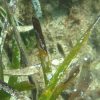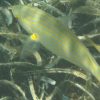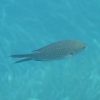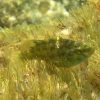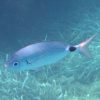Life of the Posidonia meadows
On this page:
The neptune-grass itself: a flowering plant
As snorkellers, you have long since encountered them at every turn, or rather every other fin stroke: the underwater meadows of the Mediterranean, on and next to the rocks and thus an integral part of the rock littoral. In addition to the Posidonia itself, I would like to introduce you to the most common fish species that can be found here in my experience. Very few of them use it as food; however, it offers many species a way to hide. So they can often effectively elude us snorkellers, if we notice them at all.
Of course, there is no strict separation between the species I presented to you on the previous page and those on this page.
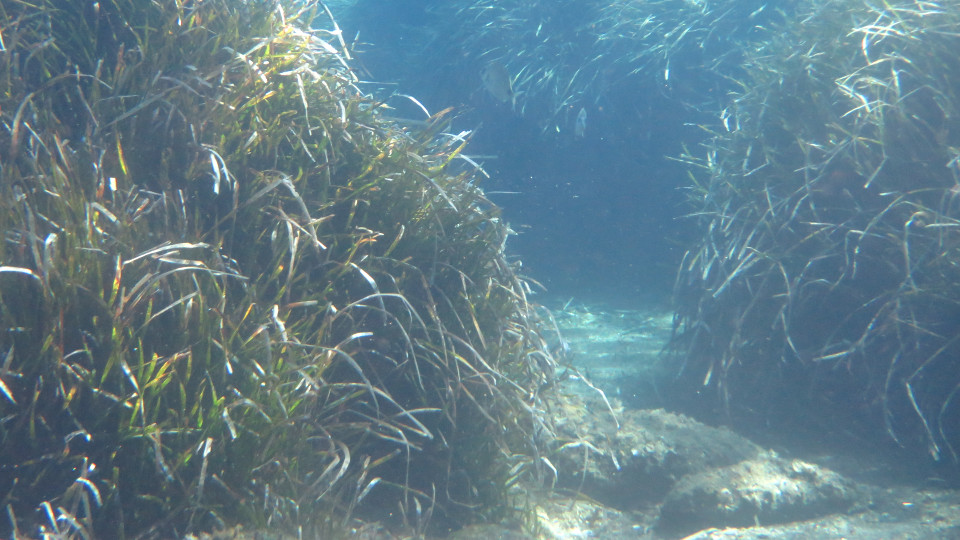
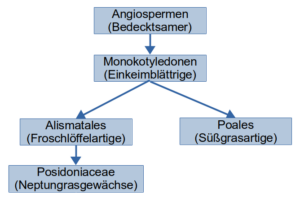
The name neptune-grass indicates a relationship with the grasses in the meadow. This relationship goes so far that Posidonia is a flowering plant (angiosperms) and, like ordinary grasses, it is a cover-seeded (Magnolopsida) and monocotyledonous plant. However, it belongs to the order of the Water Plantains (Alismatales) and there to the Posidoniaceae family, where Posidonia is the sole genus. Common grasses, on the other hand, belong to the order of Grasses (Poales) ([APG4], [APP2019], [Quelle], KIT). According to [Weinberg2015], Posidonia oceanica rarely blooms, and its flowers are inconspicuous because the pollen spreads with the water and the plant does not rely on attracting insects or other pollinators. In ordinary grasses, whose flowers are also not large or conspicuous, the wind takes over this role.
According to the IUCN Red List, Posidonia oceanica is endemic to the Mediterranean Sea and is the most widespread species of seagrass there. It is an important habitat-forming species and provides a habitat for many species. The species is listed on the Red List as a “Least Concern” (as of 2013).

While researching with the help of Wikipedia, I came across an astonishing piece of information that ultimately led me to an article by Sophie Arnaud-Haond et al. ([Arnaud2012]). According to this article, Posidonia reproduces mainly through clones, with a single clone being several kilometres long and living hundreds or even thousands of years!
The salema porgy (Sarpa salpa)
Among the species to which the Posidonia provides a habitat, the salema porgy (Sarpa salpa) is certainly one of the most commonly encountered. Probably mainly because it is one of the few fish species that eat a vegetarian diet ([Weinberg2015], [Harm94]), and Posidonia oceanica is one of its main food sources. However, it also feeds on multicellular algae, such as the green algae Ulva sp. (sea lettuce) and the red algae Laurentia pinnatafida. I was surprised to read that it is the only vertebrate that grazes Posidonia oceanica ([Jadot2002]).

Sarpa salpa belongs to the family Sparidae (sea bream) and has the characteristic forked tail. The Sparidae, on the other hand, belong to the order Perciformes (perch fish). This order is the most diverse order of all and, with about 2248 species, also the largest vertebrate order of all ([Nelson2016]). They dominate the oceans and also tropical and subtropical freshwaters. Sarpa salpa is the only species of the genus Sarpa and belongs to the subfamily Boopsinae, whose about 8 members eat a vegetarian diet (e.g. [Orrell2004]). Sarpa salpa itself is also geographically widespread far beyond the Mediterranean Sea ([Walt1998]).
Adult fish grow to 25..35 cm long, but can also reach 45 cm long ([Weinberg2015]). The colour is greenish to grey, with a dozen rather striking yellow lines along the trunk and equally striking yellow eyes. [Riedl] states that a black spot at the root of the pectoral fin is typical.
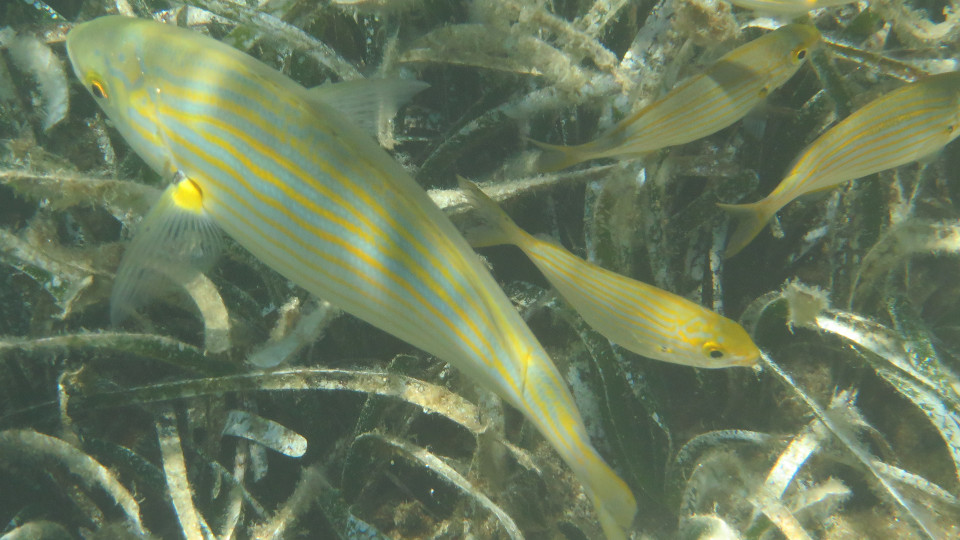
The salema porgy changes sex in the course of its lifespan, as we now know it from many other fish species. This time, however, and this is untypical, the fish begins its life as a male and later moves on to the female stage. This is called protandry (first male); Sarpa salpa is therefore a protandrian hermaphrodite ([Walt1998]).
t is emphasised in many sources (e.g. also in [Bergbauer2017]) that the salema porgy is extremely sociable and moves around in groups, even in “dense, orderly swarm formation” in shallow water depths. That’s how I got to know them myself, and you probably did too! Violent movements are to be avoided when approaching; with slow and “natural”, fish-like swimming movements – more with the diving fins – you can certainly approach them
One thing surprised me when I read about the diet of Sarpa salpa: Before they later switch to plant food, the young animals are mainly small animal eaters, who prefer to eat small crustaceans ([Bergbauer2017]). Why in this order?
But maybe this has something to do with something else that I had also read about recently, namely in [Diversity2009]: Eating plants is practically unknown among the non-Teleostei fish. This ability was only made possible by the development of pharyngeal jaws, which are “chewing apparatuses” for transporting food through the pharynx (throat) and processing it for better digestion, which have developed in the Actinopterygii. If you want to know what something like this looks like, I recommend taking a look at [Burress2016] or here at Timothy Spier.
Such a strong mechanical pre-treatment is a prerequisite for the successful subsequent chemical digestion of the food (enlargement of the surface area). The different manifestations of such changes have led to a strong diversification of nutritional strategies among the Teleostei as a whole, including plant nutrition. In this way, the Teleostei were able to gradually displace “more primitive” fish development lines that were still prevalent in the Triassic until the Cretaceous period.
Could this observation have something to do with the fact that pharyngealia in young salema porgies is not yet fully developed, for example? Could it possibly be – to speculate further – that the animals partially reproduce phylogeny (phylogenetic development) during the transition from the larval stage to adulthood in ontogeny (individual development)? I am interested in your thoughts on this as well as in further information! On the other hand, there are fish species in which the larvae eat a vegetarian diet.
Either way, I have begun to see herbivory among fish – also in comparison with terrestrial organisms, where it is also known to require significant adaptations – with different eyes. I think it makes the beautiful salema porgies even more interesting.
Damselfish (Chromis chromis)
One of the fish that can often be found in the posidonia meadows is Chromis chromis, the damselfish. According to [Weinberg2015], it is one of the most common fish in the Mediterranean, but can also be found in the eastern Atlantic to Portugal. The appearance of the animals is so striking that you can usually recognise them from a distance without any effort, as in the following picture.
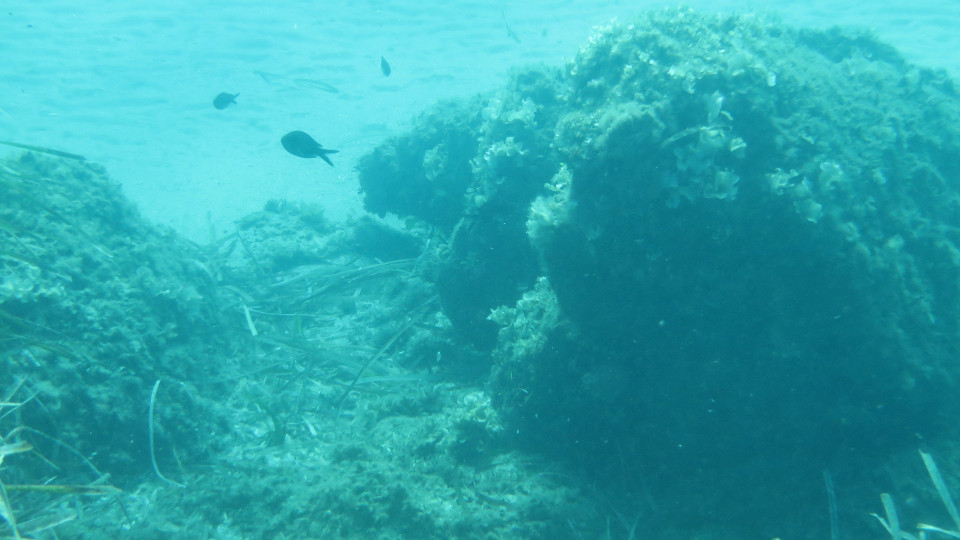
Chromis chromis belongs to the family of Pomacentridae (damselfish), most of which live in the tropical Atlantic and Indo-Pacific [Brandes-Rb]. The damselfishes also include the genus Amphiprion, the anemonefish, which are known to be very popular under the name “clownfish” at least since the movie “Finding Nemo”.

The species can be recognised by its swallow-like caudal fin with dark markings, as well as by its small protruding, upturned mouth ([Louisy2015]). The adult individuals have a grey, often dark brown ground colour. As you can see in the photo, the scales in the middle are light. Juvenile fish are intensely blue in colour. The adults are small, up to a maximum of 15 cm in length. Chromis chromis feeds exclusively on zooplankton, mainly copepods ([Dulcic1995]).
Five-spotted wrasse (Symphodus roissali)
As mentioned earlier, the posidonia provides an excellent hiding place for many residents.
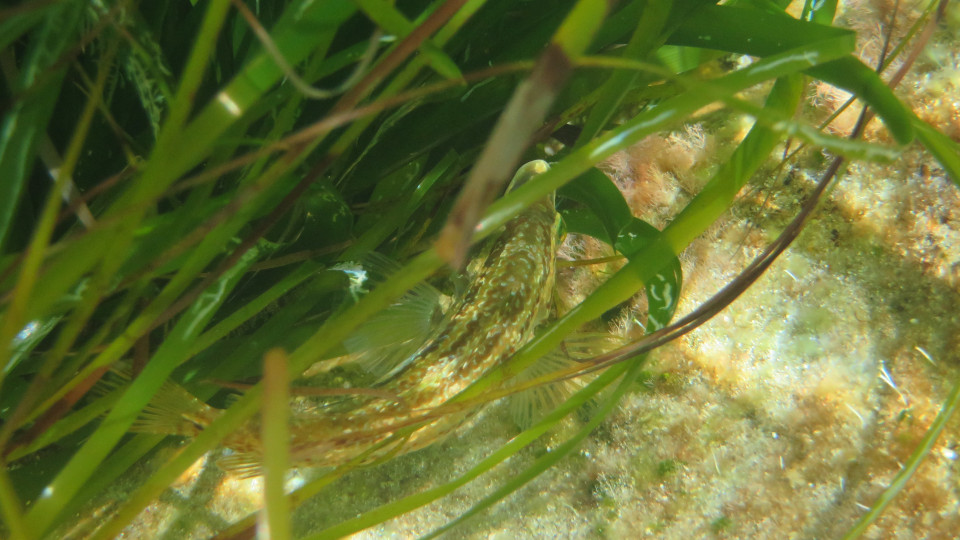
This works best if the colour and pattern match the green of the seagrass and the substrate. This is the case with Symphodus roissali, the five-spotted wrasse, as you can see here. The identification of the species was not easy for me, in part because there exists more than one species of Symphodus, and they are quite similar, at least in terms of description, and in part that the species is very variable in terms of colour, pattern and sexual dimorphism. Meanwhile, I am quite sure about the determination. I base it on [Louisy2015], [Weinberg2015], [Atlante2021], [DORIS] and the Italian Wikipedia page. I also find the vernicular name hardly helpful.
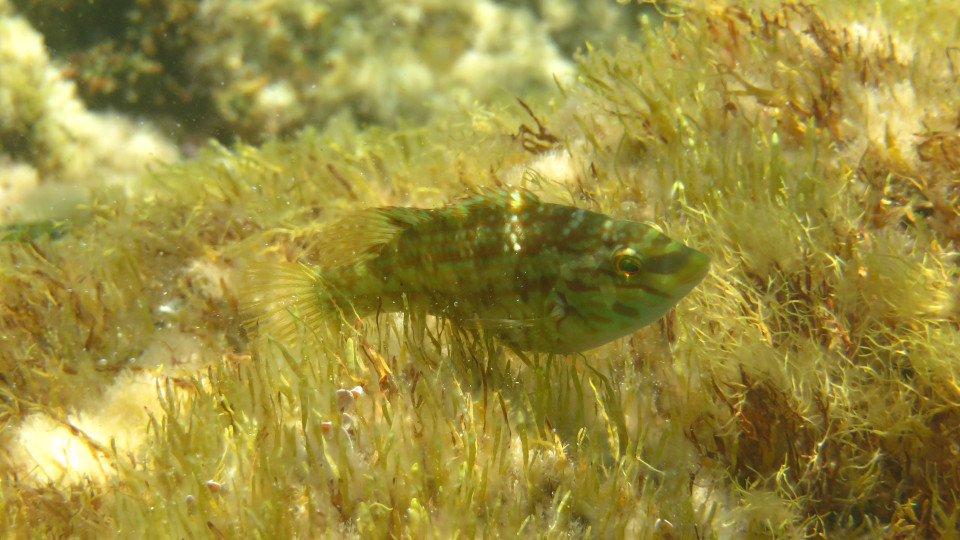
I have encountered this species on the east coast of Sardinia, and also on the Côte d’Azur and in Cabo de Gata. In Italian, by the way, it is called Tordo verde ([Atlante2021]), i.e. “green thrush”. A photo in [Atlante2021] looks like my photos, but not those in the other identification books. This could be due to the fact that the fish in my pictures and the one from [Atlante2021] can be seen in the “livrea reproduttiva”, i.e. in the “wedding garment”.
Symphodus roissali is known for its elaborate nest building, which is carried out by the male. According to [Weinberg2015], the food consists of small animals, even those just below the surface of the water, when they are released from the rocks by the surf.
Saddled seabream (Oblada melanura)
The saddled seabream (Oblada melanura) is a fish that I got to know on the Côte d’Azur, on the Île de Port-Cros, swimming over posidonia, as can be seen. I have met it quite often in other places as well.
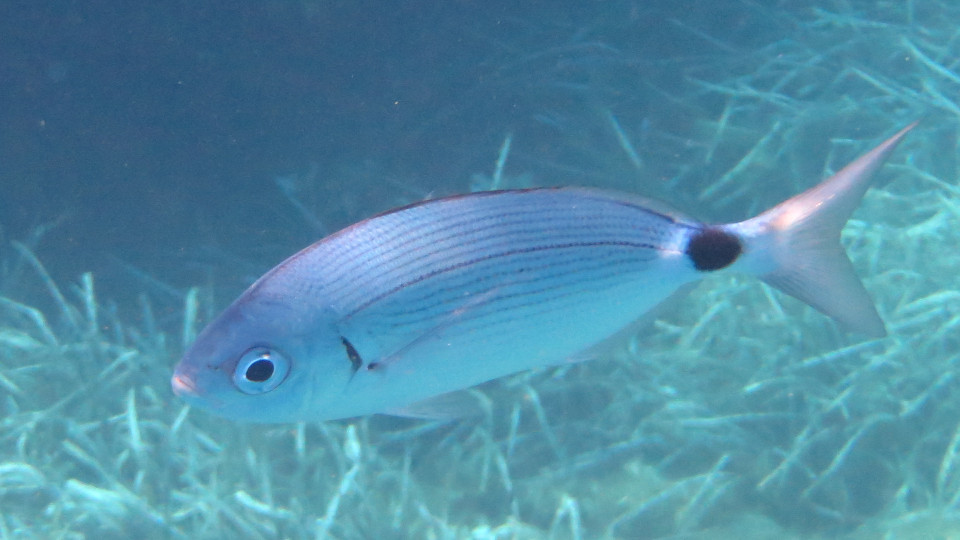
Important for recognising Oblada melanura is the black spot on the caudal peduncle framed by a white border ([Weinberg2015]). Without this white border, one could sometimes mistake it for a common white seabream. It also frequently swims in open water near the rocky shoreline.
It feeds on algae (not on posidonia) as well as on small animals that live between and on the rocks.
Golden Grey Mullet (Chelon auratus)
[Harm94] writes that mullets are among the most common inhabitants of shallow lagoons (“petits fonds herbeux des lagunes”). I have encountered these fish on several occasions in the rock littoral and on the posidonia meadows, but not as frequently as the other species described above on this page. [FishBase] confirms the neritic way of life, i.e. in the shallow sea (continental shelf).
Regarding the certainty of species identification, [Louisy 2015], 59 (in my translation) writes: “The species of the genus Liza can all have golden spots on the gill cover, and even the fishermen or experimental scientists are sometimes mistaken.” So the following photo shows a specimen of genus Liza, some species of mullet. My tip is that these specimens are Chelon auratus (synonymous with Liza aurata or Mugil auratus), the golden grey mullet.
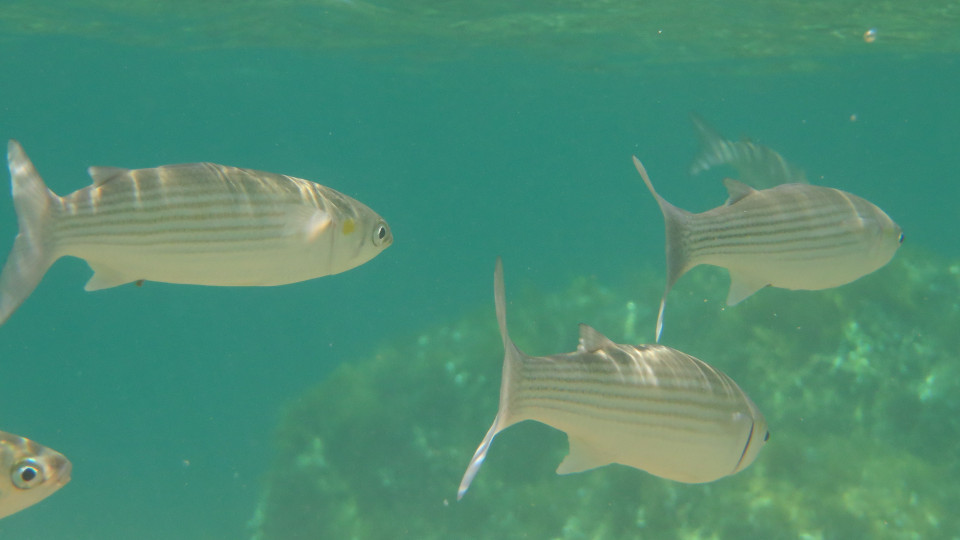
According to the latest scientific findings ([Xia2016]), the genus Chelon belongs to the subfamily Cheloninae within the family Mugilidae (mullets), which in turn belongs to the Percomorphaceae (perch relatives). As we can see, this genus has two dorsal fins and a slightly forked caudal fin (like the sea bass below).
According to [Riedl], mullets rasp off algae-covered rock, which indicates a vegetarian diet. In contrast, [FishBase] tells us that Chelon auratus feeds on small benthic organisms, detritus and occasionally insects and plankton.
European sea bass (Dicentrarchus labrax)
According to [Louisy2015], the European sea bass (Dicentrarchus labrax) is a widespread species. Its habitat is both the rocky littoral and near the sand, but he classifies it as a species that swims away from the bottom. In contrast, [FishBase] describes them as “manifest demersal”, i.e. living closer to the bottom. I tracked a specimen for a long time, although it did indeed cross different habitats – including posidonia – and moved quite close to the bottom.
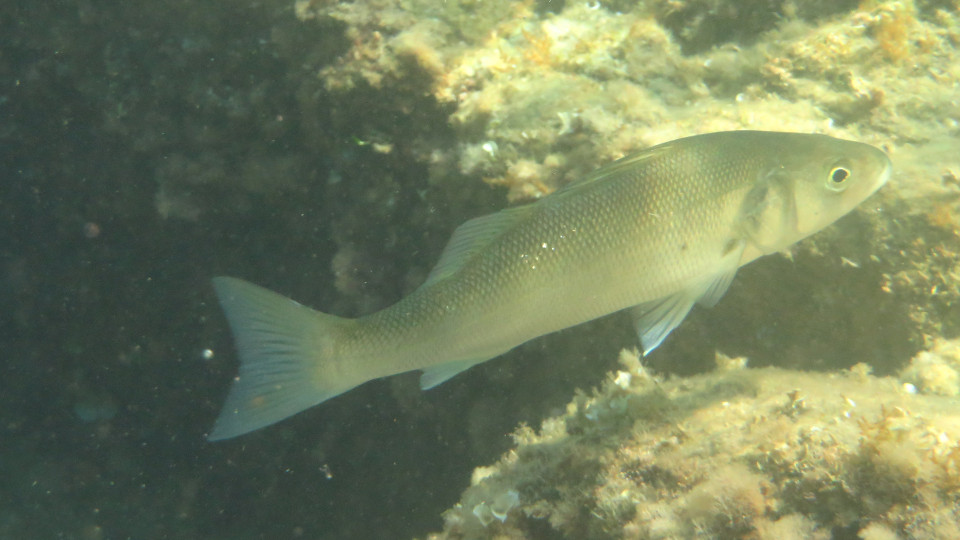
The species belongs to the Moronidae family, according to [Nelson2016] with two genera and a total of 6 species, two of them in the European and North African genus Dicentrarchus. Like all Moronidae, two dorsal fins of about the same length. Almost straight mouth, which is open towards the eye (not visible in my case), anal fin about the same length as the second dorsal. Tail fin slightly forked. Dark back, flanks silvery (doesn’t look like that to me). Diffuse black spot at the level of the gill cover. Clearly visible dandruff. The origin of the word: Dicentrarchus: Greek, di = two + Greek, kentron = sting + Greek, archos = anus. (This could easily be formulated a little more vulgar 😉 Louisy describes it as curious. Diet: Mainly shrimp and molluscs, as well as fish as they age.
The identifying features mentioned on this page are mainly from [Louisy2015], some also from [Riedl] and [FishBase]. Dietary information is usually taken from [FishBase]. The photos are my own.

